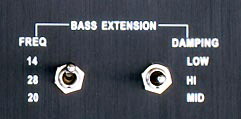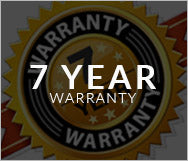You have no items in your shopping cart.
* Free UPS ground shipping to any continental US address
* Discounts when purchasing dual subs
* Discounts when sub is purchased with our speakers
$1,446.00
The Subwoofer For Audiophiles
For audiophiles looking for uncompromising accuracy, our F12 subwoofer is the ultimate choice. It features our Direct Servo technology to ensure accuracy and definition. As an audiophile you appreciate that bass is the foundation of a satisfying music or home theater experience. You also appreciate that there is more to a home theater subwoofer than shaking the room, and that music can be far more satisfying with a subwoofer that can play deep.
What makes our subwoofers suitable for audiophiles? It's not that they can plumb the depths with authority, there are already many subs on the market which can do that. The difference is that they reproduce bass with a level of realism that is normally only associated with much more expensive high end full range loudspeakers.
F12 SUBWOOFER DESCRIPTION
For audiophiles and enthusiasts looking for uncompromising accuracy in an elegant package, the F12 subwoofer is the ultimate choice. It features Direct Servo™ to ensure accurate frequency and transient response, precise detail and extremely low distortion levels at even high output levels. As a discerning listener you appreciate that bass is the foundation of a satisfying music or home theater experience. You also appreciate that there is more to a home theater subwoofer than shaking the room, and that music can be far more satisfying with a subwoofer that can play deep.
Quickguide can be found here: F12 A370PEQ3
F12 SUBWOOFER FEATURES
Features & Options
Product features include:
- Patented Direct Servo technology
- 12" black/silver anodized aluminum high excursion driver
- Solid and very inert enclosure available in a range of finishing options
- Bass extension controls allowing adjustment of bass extension and excursion control
- Selectable 12/24 db/octave crossover filter slope
- Balanced XLR connections for professional use (XLR version option)
- Parametric EQ
- Choice of finishes - black matte, black oak or piano gloss (signature edition)
All our subwoofers feature our Direct Servo technology, which is our secret to achieving tight and accurate bass. The benefits are far more than simply achieving low distortion.
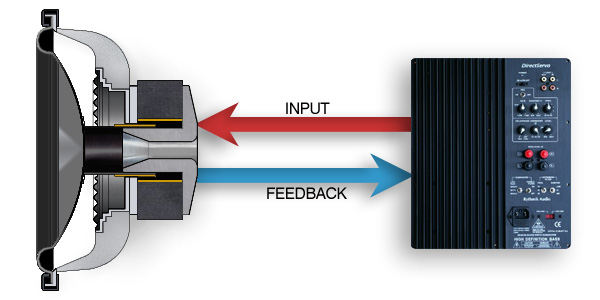
Learn more in our technology articles ![]()
12" black or silver anodized aluminum high excursion driver
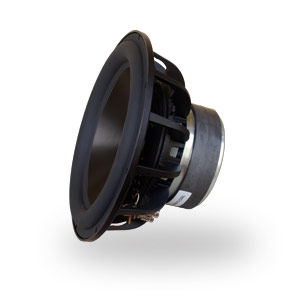
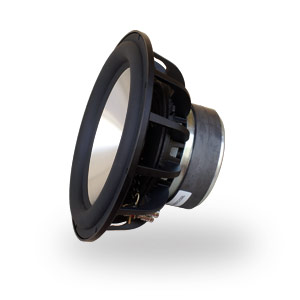
Driver features include:
- Rigid one piece anodized aluminum cone ensuring control at high SPL
- Low moving mass to ensure an exceptional transient response
- High flux density in the gap to ensure low distortion
- Flux de-modulation shorting rings to lower inductance and improve linearity
- Extended upper bandwidth response allowing a higher crossover point than most
While designed primarily for their sound quality, these custom designed drivers are also stylish in appearance with a one piece anodized aluminum cone and rubber surround. Unfortunately, it's not possible to judge the accuracy of a driver by observing its appearance. There are other drivers on the market which in fact look quite similar, and it's tempting to think that they are comparable. Many of them are inferior in performance due to a heavy moving mass, the absence of shorting rings, wider gaps around the voice coil and high inductance which limits the useable high frequency cut off point. Many aren't suitable for a crossover point higher than 50 Hz. This is very limiting when one considers the large number of home theatre speakers which perform better when relieved of bass duties.
Our enclosures are very solid and well braced to minimize any cabinet resonances or coloration. The baffle into which the driver is mounted is double thickness. Black piano gloss finish is also available in our signature edition.
All of our subwoofers feature unique bass extension controls which are not normally provided on subwoofers. This enables the user to customize the output and extension to achieve the best compromise in any room. Most subwoofers neglect to provide bass extension control, and the result is that dynamic headroom is compromised.
Crossover options for PEQ3/XLR2/XLR3 models
A370PEQ3/XLR2/XLR3: For customers with an AVR or pre-processor, we recommend LFE inputs which bypass the crossover control. In this case, the crossover should be controlled via AVR. If you are still using stereo receiver or conventional pre/power amp setup with no bass management, then we recommend LINE input and set the crossover/phase controls to where the front speakers start to roll-off. Please refer to quickguide of the model for recommendation. To understand more about how to correctly integrate your subwoofer, read our phase alignment article.
A370PEQ: A370PEQ has extra 80hz 2nd order high pass filtered RCA outputs. For customers with an AVR, we recommend LINE inputs with AVR/12 LP filter switch setting, the crossover should be then controlled via AVR. If you are still using stereo receiver or conventional pre/power amp setup with no bass management, then we recommend LINE inputs, HPF outputs, and set the crossover/phase controls to crossover at 80hz. Please refer to quickguide of the model for recommendation. To understand more about how to correctly integrate your subwoofer, read our phase alignment article.
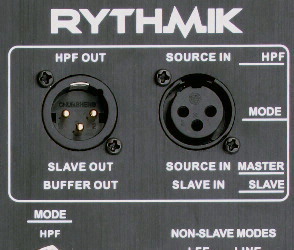 |
For professional use, a balanced input version is available. The outputs allow multiple subwoofers to be connected. Simply daisy chain the connections, running output from the first (master) subwoofer to the input of the next. For home use, balanced connections are not normally required. However, for those using studio processors and EQ units with balanced outputs, this option may be more convenient. If connection to a source with RCA connectors as found on my home audio equipment, an adaptor may be used. In this case it should be noted that the connection can no longer be considered balanced. |
Shown above is XLR2 option. Slave subwoofer units each have their own phase and PEQ adjustment, allowing for placement apart from each other. All other controls will use the same settings as the master sub. Therefore you can adjust the gain on the first and it will control the gain on all the others. The servo will still function normally, correcting any non linearities in each individual subwoofer. We also have XLR3 options with two XLR inputs and no XLR output.
For more information, including charts showing response with different settings, view our amplifier page ![]()
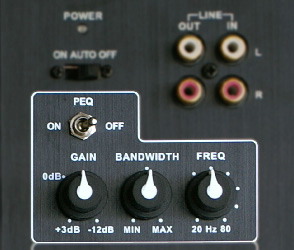 |
Our PEQ version comes with a few extra options which aren't provided on our standard amplifier. First, there is one band of parametric EQ with adjustable frequency, gain and bandwidth. This means you can not only control the boost or cut, but also the width of the filter. Additional bass management options are also provided. A switch allows the user to select a 12 or 24 db/octave crossover slope setup option. Where the higher slope (24db/octave) is selected, the amplifier uses a variable 12db/octave filter in addition to a fixed 12db/octave filter. One can choose with a switch the corner frequency of the fixed filter as either 50 or 80 Hz, which will suit most situations. The variable filter can be used for fine tuning. |
F12 SUBWOOFER SPECIFICATIONS
We use high quality high excursion drivers which make it possible to achieve high output in a relatively compact enclosure. Only with Direct Servo is it possible to achieve such deep bass extension, high output and very high damping simultaneously. The effective system Q is 0.3. A lower Q factor represents a higher level of damping, indicating control of the cone. A typical subwoofer has a Q of 0.707 and some achieve a Q as low as 0.5. The penalty is that the box is larger and the output is lower in order to achieve lower Q, but Direct Servo can achieve much lower Q without sacrificing output and making the box bigger.
When more output than one subwoofer can provide is desired, it may be tempting to look for a higher output option. Our subwoofers represent what we consider to be the output limit for an affordable and accurate subwoofer. It's possible to get higher output with one subwoofer, but not without significant compromise and additional cost. We suggest multiple subwoofers as a much better option. A side benefit is that this can also improve the integration with the acoustics of each particular room.
The bass extension controls allow the user to customize the deep bass extension and the rumble filter to control cone excursion. For high SPL, one can set a higher cut off. For music one may prefer a lower cut off. Changing the settings can also result in a better integration with the acoustic gain of the room.
| Specifications | |
| Driver | 12" high excursion with custom sensing coil |
| Driver materials | Black or silver anodized aluminum with rubber surround |
| Cast aluminum basket | |
| Aluminum flux de-modulation shorting rings | |
| Amplifier | 370W RMS class A/B patented servo controlled |
| Input Impedance | 33kohm for RCA inputs; 10kohm for XLR inputs |
| Dimensions | 15-3/4"(W) x 15-3/4" (H )x 17"(D) - (18-1/2" D with grille) |
| Shipping Weight | 75 lbs |
| Frequency Response | 14 - 200 Hz (-2 dB @ 14 Hz) with LFE inputs in A370PEQ3/XLR2/XLR3 |
| 14 - 100 Hz (-2 dB @ 14 Hz) with LINE IN inputs in all models | |
| Crossover slope | Selectable 12 or 24 dB / octave (PEQ and XLR versions) |
| Crossover range (Low pass) | 25 - 100 Hz |
| Rumble Filter (High pass ) | 20 Hz 18 dB / octave |
| Phase response | 90 degrees phase shift at 20 Hz |
| Phase adjustment | 0 - 180 degrees continuously variable |
| Bass damping factor settings | high (Q=0.5), med (Q=0.7), and low (Q=1.1) |
| Finishes | Available in black matte vinyl or black oak vinyl |
| (Piano Gloss available in signature edition only) | |
| Warranty | 5 years warranty on driver and 3 years on electronics |
| 45 day satisfaction guarantee |
F12 SUBWOOFER MEASUREMENTS
One doesn't often see a measured frequency response chart commercial subwoofers except in reviews. When the response is seen, it often becomes clear why they did not want you to see it!
A quick glance at our frequency response plot will reveal that our subwoofers do exactly what we claim. In the chart below, with bass extension controls set to 14 Hz, the response is 3 db down at 14 Hz. The response is flat and extended.

Fig 1.0 - F12 Frequency response chart in AVR/12 low pass filter setting
Looking at the frequency response you will notice that this is not a one note boom box designed to impress with exaggerated bass. Unlike conventional subwoofers, the frequency response remains flat at all output levels until the output limits have been reached.
The new A370PEQ3 amplifier, now shipped standard with F12, has an additional low pass filter setting --LFE. It extends the upper end -3db extension to 200hz.
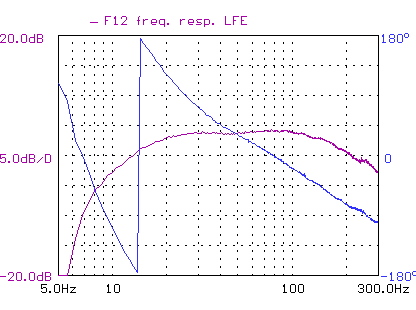
Fig 1.1 - F12 Frequency response chart in LFE low pass filter setting (only available in A370PEQ2 amp)
Integration
With many subwoofers, it is difficult to get a correct and seamless integration with the main speakers because the amplifier settings are often very different to the measured response. You may set the crossover point to 80 Hz, but the actual crossover point may be anywhere between 60 and 100 Hz!
With our subwoofers the upper and lower -3 dB points are a very close match to the settings selected. If you set bass extension to 14 Hz, that is exactly what you will get. All this is possible because Direct Servo ensures a stable and flat response.
Another aspect of getting a correct integration is phase alignment. We have written a guide on how to achieve a phase aligned subwoofer. More ![]()
F12 SUBWOOFER SUMMARY
Many of our customers marvel that we are able to produce such exceptional subwoofers at such a low price. Our Direct Servo technology makes it possible, allowing us to get the most out of a 12" driver without the need for kilowatts of power. Don't be fooled into thinking that other more expensive subwoofers with much more powerful amplifiers will offer more output. The output of a subwoofer is determined by how much air the driver can displace, not the power rating of the amplifier. We could supply a more powerful amplifier, but there would be no increase in output, only extra cost.
These are some of the finest subwoofers ever manufactured and the difference in sound quality between these subwoofers and the typical big-box ported subwoofer is surprising. You will hear the difference the very first time you listen and as so many have said, you will never go back to a non-servo subwoofer.











